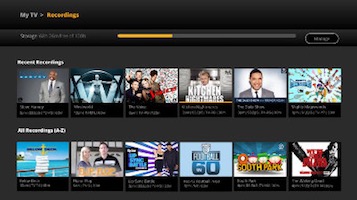
“Sling TV announces cloud DVR beta program for Roku users.” From Sling TV’s online newsroom.
On Thursday, December 15th, Dish Network (NASDAQ:DISH) subsidiary and over-the-top (OTT) television delivery service Sling TV unveiled a new cloud-based digital video recording (DVR) technology. Customers using Sling to access live television programming can store up to 100 hours of content including full-length movies, single episodes and entire television series. Automatic deletion of oldest-watched content and simultaneous recording options are also included with the service. Sling’s cloud DVR service appears to only be available to customers accessing Sling through Roku devices in this first rollout of the program and the DVR service only works with certain channels.
This new service from Sling TV is simply the latest in a wave of cloud-based services which allow consumers to store multimedia content for later watching. American telecommunications conglomerate Comcast Corporation (NASDAQ:CMCSA) offers an X1 Cloud DVR service which can be used by customers of XFINITY TV, Comcast’s own live and on-demand OTT service. X1 allows XFINITY customers to store content on cloud servers and access that content on a variety of devices. X1 even allows users to download content stored in the cloud onto a mobile device for offline viewing. Cloud DVR services are also marketed by Swedish telecom firm Ericsson (NASDAQ:ERIC) and Finnish tech company Nokia Corporation (NYSE:NOK). In early December, TechCrunch reported on information that TiVo Corporation (NASDAQ:TIVO), an early pioneer in DVR technologies, was engaged in small-scale tests to develop its own cloud-based DVR service.
The television entertainment industry, which has come to define American pop culture over the past half century and longer, has been undergoing major changes because of OTT content providers and DVR technologies. The ability to obtain scads of quality programming through streaming services like Netflix (NASDAQ:NFLX), Hulu and the Prime Video service offered by Amazon (NASDAQ:AMZN), some of which have subscription fees which are a fraction of a typical cable bill, have given American consumers every reason to “cut the cord” with major cable providers. This April, Fortune published an article describing a cable industry report which found that 1.1 million American households dropped a traditional TV subscription during 2015, pushing the percentage of American households which have either cut the cord or never subscribed to such a service past 20 percent. Statistics published by consulting firm eMarketer predicts that American households with pay-TV subscriptions will drop from 101.3 million households in 2014 down to 96.4 million in 2019. By contrast, non-pay-TV households which might instead subscribe to digital video services are expected to increase from 19.5 million up to 28.1 million during the same time period.
This trend towards non-traditional channels, especially those friendly to mobile devices, has pushed major telecoms to adapt with various services of their own. AT&T (NYSE:T) satellite broadcast subsidiary DirecTV recently unveiled DirecTV Now, which offers live and on-demand streaming of television channels like ESPN or AMC without a pay-TV subscription that bundles a large number of channels. Despite technical issues in the first few weeks of service, DirecTV Now marks a growing push towards television programming becoming more available both on-demand and through a variety of device platforms, including mobile devices.
It would not be surprising to see cloud DVR technologies becoming the subject of lawsuits in the years to come, especially those brought by copyright owners. There are at least some open questions as to the legality of cloud storage for copyright-protected material, as is reflected by an early October decision handed down by the U.S. Court of Appeals for the Second Circuit (2d Cir.) in a case involving cloud storage provided by bookseller Barnes & Noble (NYSE:BKS). A plaintiff sued Barnes & Noble for providing access to a sample of copyright-protected material after a licensing agreement between the bookseller and the author was terminated. The court found in favor of Barnes & Noble based on the terms of the distribution agreement but declined to answer judicial questions involving the novel context of cloud-based services.
The U.S. Supreme Court’s 1984 decision in Sony Corporation of America v. Universal City Studios, Inc. would prove to be important to future cases involving allegations of copyright infringement caused by cloud services. Universal City Studios had alleged that Sony’s Betamax video recording technology constituted copyright infringement by allowing users to record material in violation with the Copyright Act. The court found that, because such video recording technologies had substantial non-infringing uses such as noncommercial home recordings, Betamax did not constitute either direct or contributory infringement. Counsel representing a cloud DVR defendant would undoubtedly make a similar argument on the noninfringing uses of such technology. And before you think that such a lawsuit could never happen remember that new technologies always seem to have a way of spawning copyright litigations.

![[IPWatchdog Logo]](https://ipwatchdog.com/wp-content/themes/IPWatchdog%20-%202023/assets/images/temp/logo-small@2x.png)

![[[Advertisement]]](https://ipwatchdog.com/wp-content/uploads/2024/04/Patent-Litigation-2024-banner-938x313-1.jpeg)
![[Advertisement]](https://ipwatchdog.com/wp-content/uploads/2024/04/UnitedLex-May-2-2024-sidebar-700x500-1.jpg)
![[Advertisement]](https://ipwatchdog.com/wp-content/uploads/2024/04/Artificial-Intelligence-2024-REPLAY-sidebar-700x500-corrected.jpg)
![[Advertisement]](https://ipwatchdog.com/wp-content/uploads/2024/04/Patent-Litigation-Masters-2024-sidebar-700x500-1.jpg)

![[Advertisement]](https://ipwatchdog.com/wp-content/uploads/2021/12/WEBINAR-336-x-280-px.png)
![[Advertisement]](https://ipwatchdog.com/wp-content/uploads/2021/12/2021-Patent-Practice-on-Demand-recorded-Feb-2021-336-x-280.jpg)
![[Advertisement]](https://ipwatchdog.com/wp-content/uploads/2021/12/Ad-4-The-Invent-Patent-System™.png)






Join the Discussion
No comments yet.